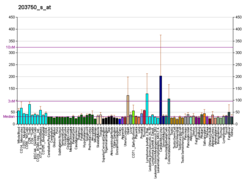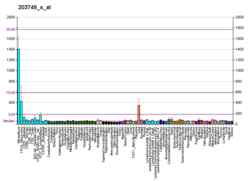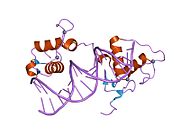Retinoic acid receptor alpha
Retinoic acid receptor alpha (RAR-α), also known as NR1B1 (nuclear receptor subfamily 1, group B, member 1) is a nuclear receptor that in humans is encoded by the RARA gene.[5][6]
NR1B1 is a gene with a protein product and has a chromosomal location of 17q21.2. RARA codes for the nuclear hormone receptor Retinoic Acid Receptor, Alpha subtype, and are themselves transcription factors. There are another 2 subtypes of RARs, Beta subtype, and Gamma subtype.[7][8]
Function[]
Retinoid signaling is transduced by 2 families of nuclear receptors, retinoic acid receptor (RAR) and retinoid X receptor (RXR), which form RXR/RAR heterodimers. In the absence of ligand, DNA-bound RXR/RARA represses transcription by recruiting the corepressors NCOR1, SMRT (NCOR2), and histone deacetylase. When ligand binds to the complex, it induces a conformational change allowing the recruitment of coactivators, histone acetyltransferases, and the basic transcription machinery.[9]
Retinoic Acid Receptor Alpha, the protein, interacts with retinoic acid, a derivative of Vitamin A, which plays an important role in cell growth, differentiation, and the formation of organs in embryonic development.[8][10]
Once Retinoic Acid binds to the RAR, they initiate transcription and allow for their respective gene to be expressed. [10]
Clinical significance[]
RA signaling has been correlated with several signaling pathways in early embryonic development. First, it participates in the formation of the , which establishes symmetry in the offspring. RA also influences neural differentiation by regulating the expression of pro-neural induction factor Neurogenin 2 (Neurog2). RA affects cardiogenesis, as it plays a role specifically in the formation of the atrial chambers of the heart. RA also plays a role in the development of the pancreas, kidneys, lungs, and extremities. [10]
Translocations that always involve rearrangement of the RARA gene are a cardinal feature of acute promyelocytic leukemia (APL; MIM 612376). The most frequent translocation is t(15,17)(q21;q22), which fuses the RARA gene with the PML gene.[11]
Interactions[]
Retinoic acid receptor alpha has been shown to interact with:
Genetic Studies[]
Knock-out mice studies showed that a deletion in one of the copies of the RARA gene did not create any observable defect, while deletion of both copies shoes symptoms similar to that of Vitamin A deficiency. This proved that all 3 subtypes of RARs work redundantly.
See also[]
- Retinoic acid receptor
- Retinoic X Receptor
- Acute promyelocytic leukemia
References[]
- ^ a b c GRCh38: Ensembl release 89: ENSG00000131759 - Ensembl, May 2017
- ^ a b c GRCm38: Ensembl release 89: ENSMUSG00000037992 - Ensembl, May 2017
- ^ "Human PubMed Reference:". National Center for Biotechnology Information, U.S. National Library of Medicine.
- ^ "Mouse PubMed Reference:". National Center for Biotechnology Information, U.S. National Library of Medicine.
- ^ Giguere V, Ong ES, Segui P, Evans RM (1987). "Identification of a receptor for the morphogen retinoic acid". Nature. 330 (6149): 624–9. Bibcode:1987Natur.330..624G. doi:10.1038/330624a0. PMID 2825036. S2CID 4308015.
- ^ Anderson LA, Friedman L, Osborne-Lawrence S, Lynch E, Weissenbach J, Bowcock A, King MC (September 1993). "High-density genetic map of the BRCA1 region of chromosome 17q12-q21". Genomics. 17 (3): 618–23. doi:10.1006/geno.1993.1381. PMID 8244378.
- ^ "Gene symbol report | HUGO Gene Nomenclature Committee". www.genenames.org. Retrieved 2021-04-27.
- ^ a b "OMIM Entry - * 180240 - RETINOIC ACID RECEPTOR, ALPHA; RARA". www.omim.org. Retrieved 2021-04-27.
- ^ "Entrez Gene: retinoic acid receptor".
- ^ a b c Kam RK, Deng Y, Chen Y, Zhao H (March 2012). "Retinoic acid synthesis and functions in early embryonic development". Cell & Bioscience. 2 (1): 11. doi:10.1186/2045-3701-2-11. PMC 3325842. PMID 22439772.
- ^ Vitoux D, Nasr R, de The H (2007). "Acute promyelocytic leukemia: new issues on pathogenesis and treatment response". The International Journal of Biochemistry & Cell Biology. 39 (6): 1063–70. doi:10.1016/j.biocel.2007.01.028. PMID 17468032.
- ^ Liu R, Takayama S, Zheng Y, Froesch B, Chen GQ, Zhang X, et al. (July 1998). "Interaction of BAG-1 with retinoic acid receptor and its inhibition of retinoic acid-induced apoptosis in cancer cells". The Journal of Biological Chemistry. 273 (27): 16985–92. doi:10.1074/jbc.273.27.16985. PMID 9642262.
- ^ a b McNamara P, Seo SB, Rudic RD, Sehgal A, Chakravarti D, FitzGerald GA (June 2001). "Regulation of CLOCK and MOP4 by nuclear hormone receptors in the vasculature: a humoral mechanism to reset a peripheral clock". Cell. 105 (7): 877–89. doi:10.1016/S0092-8674(01)00401-9. PMID 11439184. S2CID 6251321.
- ^ Despouy G, Bastie JN, Deshaies S, Balitrand N, Mazharian A, Rochette-Egly C, et al. (February 2003). "Cyclin D3 is a cofactor of retinoic acid receptors, modulating their activity in the presence of cellular retinoic acid-binding protein II". The Journal of Biological Chemistry. 278 (8): 6355–62. doi:10.1074/jbc.M210697200. PMID 12482873.
- ^ Lee SK, Jung SY, Kim YS, Na SY, Lee YC, Lee JW (February 2001). "Two distinct nuclear receptor-interaction domains and CREB-binding protein-dependent transactivation function of activating signal cointegrator-2". Molecular Endocrinology. 15 (2): 241–54. doi:10.1210/me.15.2.241. PMID 11158331.
- ^ Lee SK, Anzick SL, Choi JE, Bubendorf L, Guan XY, Jung YK, et al. (November 1999). "A nuclear factor, ASC-2, as a cancer-amplified transcriptional coactivator essential for ligand-dependent transactivation by nuclear receptors in vivo". The Journal of Biological Chemistry. 274 (48): 34283–93. doi:10.1074/jbc.274.48.34283. PMID 10567404.
- ^ Ko L, Cardona GR, Chin WW (May 2000). "Thyroid hormone receptor-binding protein, an LXXLL motif-containing protein, functions as a general coactivator". Proceedings of the National Academy of Sciences of the United States of America. 97 (11): 6212–7. Bibcode:2000PNAS...97.6212K. doi:10.1073/pnas.97.11.6212. PMC 18584. PMID 10823961.
- ^ Dowell P, Ishmael JE, Avram D, Peterson VJ, Nevrivy DJ, Leid M (May 1999). "Identification of nuclear receptor corepressor as a peroxisome proliferator-activated receptor alpha interacting protein". The Journal of Biological Chemistry. 274 (22): 15901–7. doi:10.1074/jbc.274.22.15901. PMID 10336495.
- ^ Guidez F, Ivins S, Zhu J, Söderström M, Waxman S, Zelent A (April 1998). "Reduced retinoic acid-sensitivities of nuclear receptor corepressor binding to PML- and PLZF-RARalpha underlie molecular pathogenesis and treatment of acute promyelocytic leukemia". Blood. 91 (8): 2634–42. doi:10.1182/blood.V91.8.2634.2634_2634_2642. PMID 9531570.
- ^ Dong S, Tweardy DJ (April 2002). "Interactions of STAT5b-RARalpha, a novel acute promyelocytic leukemia fusion protein, with retinoic acid receptor and STAT3 signaling pathways". Blood. 99 (8): 2637–46. doi:10.1182/blood.V99.8.2637. PMID 11929748.
- ^ Hong SH, David G, Wong CW, Dejean A, Privalsky ML (August 1997). "SMRT corepressor interacts with PLZF and with the PML-retinoic acid receptor alpha (RARalpha) and PLZF-RARalpha oncoproteins associated with acute promyelocytic leukemia". Proceedings of the National Academy of Sciences of the United States of America. 94 (17): 9028–33. Bibcode:1997PNAS...94.9028H. doi:10.1073/pnas.94.17.9028. PMC 23013. PMID 9256429.
- ^ Hu X, Chen Y, Farooqui M, Thomas MC, Chiang CM, Wei LN (January 2004). "Suppressive effect of receptor-interacting protein 140 on coregulator binding to retinoic acid receptor complexes, histone-modifying enzyme activity, and gene activation". The Journal of Biological Chemistry. 279 (1): 319–25. doi:10.1074/jbc.M307621200. PMID 14581481.
- ^ Farooqui M, Franco PJ, Thompson J, Kagechika H, Chandraratna RA, Banaszak L, Wei LN (February 2003). "Effects of retinoid ligands on RIP140: molecular interaction with retinoid receptors and biological activity". Biochemistry. 42 (4): 971–9. doi:10.1021/bi020497k. PMID 12549917.
- ^ L'Horset F, Dauvois S, Heery DM, Cavaillès V, Parker MG (November 1996). "RIP-140 interacts with multiple nuclear receptors by means of two distinct sites". Molecular and Cellular Biology. 16 (11): 6029–36. doi:10.1128/MCB.16.11.6029. PMC 231605. PMID 8887632.
- ^ Seol W, Choi HS, Moore DD (May 1996). "An orphan nuclear hormone receptor that lacks a DNA binding domain and heterodimerizes with other receptors". Science. 272 (5266): 1336–9. Bibcode:1996Sci...272.1336S. doi:10.1126/science.272.5266.1336. PMID 8650544. S2CID 32853062.
- ^ Seol W, Hanstein B, Brown M, Moore DD (October 1998). "Inhibition of estrogen receptor action by the orphan receptor SHP (short heterodimer partner)". Molecular Endocrinology. 12 (10): 1551–7. doi:10.1210/me.12.10.1551. PMID 9773978.
- ^ Perlmann T, Jansson L (April 1995). "A novel pathway for vitamin A signaling mediated by RXR heterodimerization with NGFI-B and NURR1". Genes & Development. 9 (7): 769–82. doi:10.1101/gad.9.7.769. PMID 7705655.
- ^ Zhong S, Delva L, Rachez C, Cenciarelli C, Gandini D, Zhang H, et al. (November 1999). "A RA-dependent, tumour-growth suppressive transcription complex is the target of the PML-RARalpha and T18 oncoproteins". Nature Genetics. 23 (3): 287–95. doi:10.1038/15463. PMID 10610177. S2CID 23613492.
- ^ Benkoussa M, Brand C, Delmotte MH, Formstecher P, Lefebvre P (July 2002). "Retinoic acid receptors inhibit AP1 activation by regulating extracellular signal-regulated kinase and CBP recruitment to an AP1-responsive promoter". Molecular and Cellular Biology. 22 (13): 4522–34. doi:10.1128/MCB.22.13.4522-4534.2002. PMC 133906. PMID 12052862.
- ^ Bugge TH, Pohl J, Lonnoy O, Stunnenberg HG (April 1992). "RXR alpha, a promiscuous partner of retinoic acid and thyroid hormone receptors". The EMBO Journal. 11 (4): 1409–18. doi:10.1002/j.1460-2075.1992.tb05186.x. PMC 556590. PMID 1314167.
- ^ Kim HJ, Yi JY, Sung HS, Moore DD, Jhun BH, Lee YC, Lee JW (September 1999). "Activating signal cointegrator 1, a novel transcription coactivator of nuclear receptors, and its cytosolic localization under conditions of serum deprivation". Molecular and Cellular Biology. 19 (9): 6323–32. doi:10.1128/mcb.19.9.6323. PMC 84603. PMID 10454579.
- ^ He B, Wilson EM (March 2003). "Electrostatic modulation in steroid receptor recruitment of LXXLL and FXXLF motifs". Molecular and Cellular Biology. 23 (6): 2135–50. doi:10.1128/MCB.23.6.2135-2150.2003. PMC 149467. PMID 12612084.
- ^ Zeng M, Kumar A, Meng G, Gao Q, Dimri G, Wazer D, et al. (November 2002). "Human papilloma virus 16 E6 oncoprotein inhibits retinoic X receptor-mediated transactivation by targeting human ADA3 coactivator". The Journal of Biological Chemistry. 277 (47): 45611–8. doi:10.1074/jbc.M208447200. PMID 12235159.
- ^ Martin PJ, Delmotte MH, Formstecher P, Lefebvre P (September 2003). "PLZF is a negative regulator of retinoic acid receptor transcriptional activity". Nuclear Receptor. 1 (1): 6. doi:10.1186/1478-1336-1-6. PMC 212040. PMID 14521715.
Further reading[]
- Petkovich M, Brand NJ, Krust A, Chambon P (1988). "A human retinoic acid receptor which belongs to the family of nuclear receptors". Nature. 330 (6147): 444–50. doi:10.1038/330444a0. PMID 2825025. S2CID 4271628.
- Sirulnik A, Melnick A, Zelent A, Licht JD (September 2003). "Molecular pathogenesis of acute promyelocytic leukaemia and APL variants". Best Practice & Research. Clinical Haematology. 16 (3): 387–408. doi:10.1016/S1521-6926(03)00062-8. PMID 12935958.
- Kliewer SA, Umesono K, Mangelsdorf DJ, Evans RM (January 1992). "Retinoid X receptor interacts with nuclear receptors in retinoic acid, thyroid hormone and vitamin D3 signalling". Nature. 355 (6359): 446–9. Bibcode:1992Natur.355..446K. doi:10.1038/355446a0. PMC 6159885. PMID 1310351.
- Kastner P, Perez A, Lutz Y, Rochette-Egly C, Gaub MP, Durand B, et al. (February 1992). "Structure, localization and transcriptional properties of two classes of retinoic acid receptor alpha fusion proteins in acute promyelocytic leukemia (APL): structural similarities with a new family of oncoproteins". The EMBO Journal. 11 (2): 629–42. doi:10.1002/j.1460-2075.1992.tb05095.x. PMC 556495. PMID 1311253.
- Baniahmad A, Köhne AC, Renkawitz R (March 1992). "A transferable silencing domain is present in the thyroid hormone receptor, in the v-erbA oncogene product and in the retinoic acid receptor". The EMBO Journal. 11 (3): 1015–23. doi:10.1002/j.1460-2075.1992.tb05140.x. PMC 556542. PMID 1347744.
- de Thé H, Lavau C, Marchio A, Chomienne C, Degos L, Dejean A (August 1991). "The PML-RAR alpha fusion mRNA generated by the t(15;17) translocation in acute promyelocytic leukemia encodes a functionally altered RAR". Cell. 66 (4): 675–84. doi:10.1016/0092-8674(91)90113-D. PMID 1652369. S2CID 40272758.
- de Thé H, Chomienne C, Lanotte M, Degos L, Dejean A (October 1990). "The t(15;17) translocation of acute promyelocytic leukaemia fuses the retinoic acid receptor alpha gene to a novel transcribed locus". Nature. 347 (6293): 558–61. Bibcode:1990Natur.347..558D. doi:10.1038/347558a0. PMID 2170850. S2CID 4314933.
- Brand NJ, Petkovich M, Chambon P (December 1990). "Characterization of a functional promoter for the human retinoic acid receptor-alpha (hRAR-alpha)". Nucleic Acids Research. 18 (23): 6799–806. doi:10.1093/nar/18.23.6799. PMC 332734. PMID 2175878.
- Borrow J, Goddard AD, Sheer D, Solomon E (September 1990). "Molecular analysis of acute promyelocytic leukemia breakpoint cluster region on chromosome 17". Science. 249 (4976): 1577–80. Bibcode:1990Sci...249.1577B. doi:10.1126/science.2218500. PMID 2218500.
- Arveiler B, Petkovich M, Mandel JL, Chambon P (July 1988). "A PstI RFLP for the human retinoic acid receptor in 17q21". Nucleic Acids Research. 16 (13): 6252. doi:10.1093/nar/16.13.6252. PMC 336887. PMID 2899875.
- Chen JD, Evans RM (October 1995). "A transcriptional co-repressor that interacts with nuclear hormone receptors". Nature. 377 (6548): 454–7. Bibcode:1995Natur.377..454C. doi:10.1038/377454a0. PMID 7566127. S2CID 4361329.
- Fisher GJ, Talwar HS, Xiao JH, Datta SC, Reddy AP, Gaub MP, et al. (August 1994). "Immunological identification and functional quantitation of retinoic acid and retinoid X receptor proteins in human skin". The Journal of Biological Chemistry. 269 (32): 20629–35. doi:10.1016/S0021-9258(17)32039-2. PMID 8051161.
- Chen Z, Guidez F, Rousselot P, Agadir A, Chen SJ, Wang ZY, et al. (February 1994). "PLZF-RAR alpha fusion proteins generated from the variant t(11;17)(q23;q21) translocation in acute promyelocytic leukemia inhibit ligand-dependent transactivation of wild-type retinoic acid receptors". Proceedings of the National Academy of Sciences of the United States of America. 91 (3): 1178–82. Bibcode:1994PNAS...91.1178C. doi:10.1073/pnas.91.3.1178. PMC 521477. PMID 8302850.
- Redner RL, Rush EA, Faas S, Rudert WA, Corey SJ (February 1996). "The t(5;17) variant of acute promyelocytic leukemia expresses a nucleophosmin-retinoic acid receptor fusion". Blood. 87 (3): 882–6. doi:10.1182/blood.V87.3.882.bloodjournal873882. PMID 8562957.
- Kamei Y, Xu L, Heinzel T, Torchia J, Kurokawa R, Gloss B, et al. (May 1996). "A CBP integrator complex mediates transcriptional activation and AP-1 inhibition by nuclear receptors". Cell. 85 (3): 403–14. doi:10.1016/S0092-8674(00)81118-6. PMID 8616895. S2CID 16273727.
- Liu W, Hellman P, Li Q, Yu WR, Juhlin C, Nordlinder H, et al. (December 1996). "Biosynthesis and function of all-trans- and 9-cis-retinoic acid in parathyroid cells". Biochemical and Biophysical Research Communications. 229 (3): 922–9. doi:10.1006/bbrc.1996.1903. PMID 9005841.
- Thénot S, Henriquet C, Rochefort H, Cavaillès V (May 1997). "Differential interaction of nuclear receptors with the putative human transcriptional coactivator hTIF1". The Journal of Biological Chemistry. 272 (18): 12062–8. doi:10.1074/jbc.272.18.12062. PMID 9115274.
This article incorporates text from the United States National Library of Medicine, which is in the public domain.
- Genes on human chromosome 17
- Intracellular receptors
- Transcription factors










